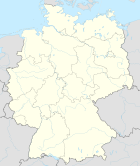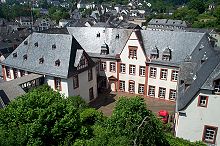Association municipality Saarburg
| coat of arms | Germany map | |
|---|---|---|

|
Coordinates: 49 ° 37 ' N , 6 ° 33' E |
|
| Basic data (as of 2019) | ||
| Existing period: | 1970-2019 | |
| State : | Rhineland-Palatinate | |
| County : | Trier-Saarburg | |
| Area : | 199.14 km 2 | |
| Residents: | 23,581 (Dec. 31, 2017) | |
| Population density : | 118 inhabitants per km 2 | |
| License plate : | TR, SAB | |
| Association key : | 07 2 35 5005 | |
| Association structure: | 16 municipalities | |
| Association administration address : |
Schlossberg 6 54439 Saarburg |
|
The Saarburg Association was a Rhineland-Palatinate association in the south-western part of the Trier-Saarburg district and was formed from the city of Saarburg and 15 other independent local communities . It had its administrative seat in Haus Warsberg in Saarburg. Over 23,000 people lived in the 199 km² area.
geography
The community extended from the Upper Moselle in the west to the Hunsrück border area in the east, in the south the area was defined by the state border Rhineland-Palatinate / Saarland, in the north it bordered the community of Konz .
Geographically, the landscape was divided into three levels: the Saar valley communities , which are also wine-growing areas, the agricultural Saargau communities and the wine and mixed- farming communities of the Upper Moselle. The heights were between 140 and 440 meters.
Association members communities
| Surname | Area (km²) |
Inhabitants (1950) |
Population (December 31, 2017) |
|---|---|---|---|
|
|
7.58 | 931 | 1,555 |
|
|
6.88 | 302 | 415 |
|
|
11.00 | 1,396 | 1,775 |
|
|
15.21 | 1,249 | 1,517 |
|
|
5.23 | 455 | 419 |
|
|
19.15 | 954 | 824 |
|
|
6.02 | 349 | 327 |
|
|
18.21 | 916 | 798 |
|
|
2.46 | 495 | 606 |
|
|
21.30 | 1,378 | 1,501 |
|
|
20.36 | 4,942 | 7,377 |
|
|
5.14 | 393 | 691 |
|
|
17.63 | 1,431 | 1,657 |
|
|
16.16 | 752 | 786 |
|
|
7.53 | 650 | 1,163 |
|
|
18.72 | 1,543 | 2,170 |
|
|
198.70 | 18,136 | 23,581 |
history
The history of the communities in the Saarburg Association dates back to prehistoric times. Finds from the Stone , Bronze and Iron Ages as well as Celtic walls bear witness to an early settlement. During the Roman period (1st century BC to 5th century AD), the area of the Saarburg association had a flourishing villa culture. Finds from Roman times can be found in almost every local community. The Romans planted vines on the Saar and Moselle for the first time and ensured an orderly transport infrastructure.
In the 5th century, the Romans were driven out by the Franks advancing west and the country devastated. The repopulation of the Saarburg area began as early as the 7th century. The first documentary mentions of some of the localities in the area of the association come from this period. The further history of the Verbandsgemeinde can be traced from this period by means of documents. The city of Saarburg, located at the foot of the castle built by Count Siegfried in 964 , received city rights in 1291 from King Rudolf von Habsburg . Due to the city charter and its geographically and strategically important location, Saarburg developed a prominent position as the center on the lower Saar. During the French period (1794–1815) Saarburg became the seat of the canton and after 1815 a district town ( Saarburg district ) in the Trier administrative district of the Prussian Rhine province .
While viticulture and agriculture dominated in Saarburg, the city of Saarburg was home to fishing, shipping and handicrafts. In 1914, over 80 Saarburg families owned ships. Former city guilds indicate a brisk economic life.
Due to the proximity of the Saarburg area to France, the country was often the scene of armed conflicts. The armed events, which strung together over the centuries, severely disrupted economic life until recently. During the Second World War , the population of Saarburger Land was evacuated twice and at the end of the war the city of Saarburg and some localities were destroyed. The development of international understanding and economic cooperation between the countries of Europe that began after the Second World War is now bearing fruit in the Saarburger Land.
With the eighth state law on administrative simplification in the state of Rhineland-Palatinate, the Saarburg association was re-established with effect from November 7, 1970. She is the legal successor to the dissolved municipalities of Palzem , Saarburg-Land and Saarburg-Ost. The area of the community of Saarburg coincided almost completely with the area of the former Kurtrierisches Amt Saarburg (city of Saarburg, Irscher Pflege und Gaupflege) and the former Luxembourg area on the Upper Moselle .
On January 1, 2019, the new community of Saarburg-Kell was created through the merger with the community of Kell am See .
Population development
The development of the population, based on the area of the Verbandsgemeinde Saarburg at the time of dissolution, the values from 1871 to 1987 are based on censuses:
|
|
politics
Association municipal council
The Saarburg municipal council consisted of 36 volunteer council members who were elected in a personalized proportional representation in the local elections on May 25, 2014 , and the full-time mayor as chairman.
The distribution of seats in the municipal council:
| choice | SPD | CDU | GREEN | FWG | total |
|---|---|---|---|---|---|
| 2014 | 9 | 17th | 3 | 7th | 36 seats |
| 2009 | 9 | 17th | 3 | 7th | 36 seats |
| 2004 | 10 | 19th | - | 7th | 36 seats |
- FWG = Free Voting Group Verbandsgemeinde Saarburg e. V.
mayor
- 1971 - 1993 Hans Houy
- 1994 - 2005 Günther Schartz
- 2006 - 2013 Leo Lauer
- 2014 - 2018 Jürgen Dixius, from 2019 mayor of the Saarburg-Kell association
badges and flags
The Verbandsgemeinde carried a coat of arms and a flag .
economy
The position of the Mittelzentrum Saarburg as a place of work for the population of the city and the surrounding area is shown in the positive commuter balance. The number of jobs has increased over the past few decades.
The economic structure is predominantly medium-sized. The local handicraft and trading companies largely serve to supply the city and its catchment area. In designated industrial areas, there are still areas available for further settlement of low-emission companies in the manufacturing industry. The business location has close economic ties to neighboring Luxembourg. Despite changed economic structures, agriculture still plays a major role in the Saarburg community, especially on the fertile soils of the Saargau . Viticulture can be described as the economic trademark of the Saarburg Association. In Saarburg and in the well-known wine-growing communities of the Saar Valley, first-class Saar Riesling wines with an international reputation grow in well-known good locations on steep slate slopes. The Elbling wine grows as a special rarity on the Upper Moselle . a. is also preferred for the production of selected sparkling wines; Burgundy varieties are increasingly being produced and marketed here. The profitability of traditional small and family wine-growing businesses is based on the production of high-quality wines as well as on well-organized cooperative wine marketing. Despite fierce international competition, the vintners of the Saarburg Association were able to maintain their places on the sales market.
tourism
The community of Saarburg was embedded in a diverse natural landscape and there is a multitude of historical and historical sights in the city of Saarburg and in every local community. Particularly noteworthy is the medieval town center of Saarburg with narrow streets and nooks and crannies, the historic castle complex high above the old town with its colorful fishermen's and boatmen's houses and the imposing Leuk waterfall in the city center. Since the beginning of the 1970s, tourism in the association has been promoted through special measures.
In addition to the numerous historical sights, the many thousands of holidaymakers had a wide range of leisure and recreational facilities at their disposal. The many sports centers, the modern outdoor adventure pool and the family-friendly indoor leisure pool, summer toboggan run, birds of prey park, municipal museum and cultural meeting point "Amüseum", museum Hackenberger Mühle, bell foundry museum, sports boat harbor, rowing piers, ship landing stage for passenger rides, dance hall, riding stadium are particularly worth mentioning , Tennis and bowling hall etc. The city hall in Saarburg is available for cultural and other events. For nature lovers, there are well-developed networks of cycling and hiking trails, Nordic walking routes and theme-oriented nature trails within the community.
traffic
The federal roads 51 (on the Saar), 407 (partly Hunsrückhöhenstrasse ) and 419 (on the Upper Moselle) as well as other state , district and municipal roads ran through the territory of the Verbandsgemeinde .
literature
- Ewald Wegner (arrangement): District of Trier-Saarburg. Verbandsgemeinden Hermeskeil, Kell, Konz, Saarburg (= cultural monuments in Rhineland-Palatinate. Monument topography Federal Republic of Germany . Volume 12.1 ). Wernersche Verlagsgesellschaft, Worms 1994, ISBN 3-88462-100-9 .
Web links
Individual evidence
- ↑ a b State Statistical Office Rhineland-Palatinate - regional data
- ↑ State Statistical Office of Rhineland-Palatinate - population status 2019, districts, communities, association communities ( help on this ).
- ↑ The Regional Returning Officer Rhineland-Palatinate: Municipal elections 2014, Verbandsgemeinderatswahlen
- ^ Flag of Saarburg Administrative Court


